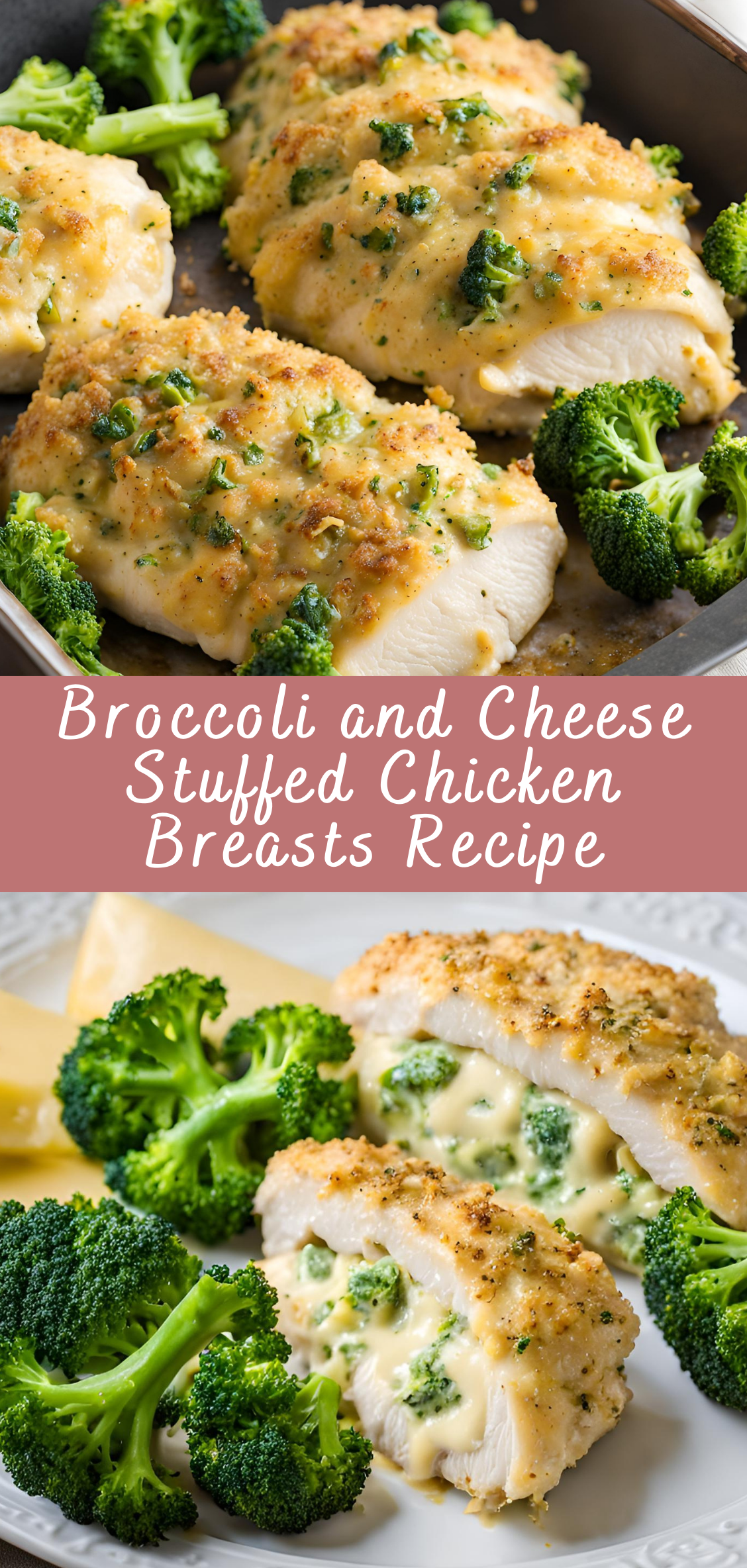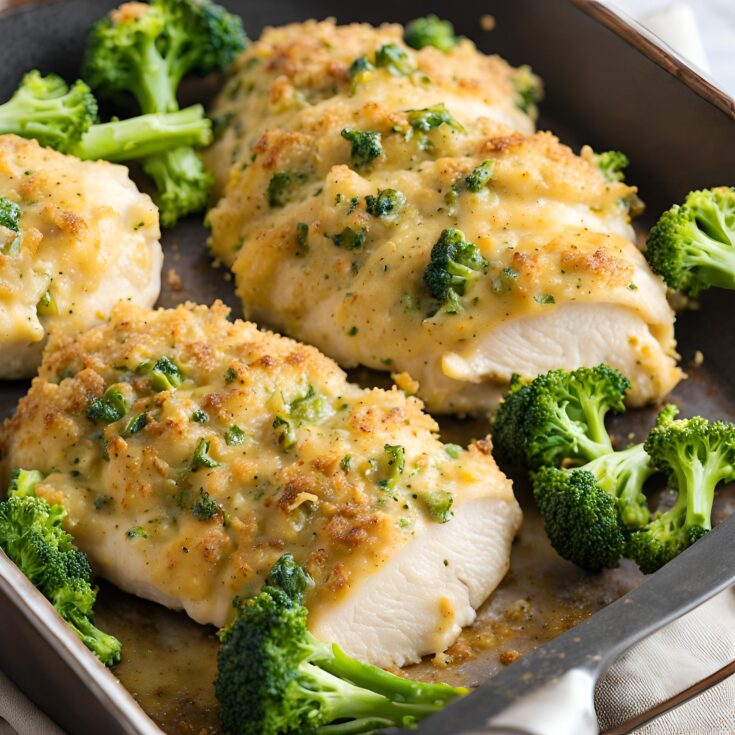Broccoli and Cheese Stuffed Chicken Breasts Recipe
If you’re looking for a meal that’s both nutritious and indulgent, Broccoli and Cheese Stuffed Chicken Breasts is a perfect choice. This recipe combines the lean, protein-packed goodness of chicken with the creaminess and richness of cheese, along with the health benefits of broccoli. The result? A dish that’s delicious, hearty, and packed with flavor.

Whether you’re looking to impress guests at a dinner party or make a healthy, filling meal for your family on a weeknight, this dish is versatile, simple, and satisfying. You can customize it with your favorite cheeses, seasonings, and herbs, and it’s easy to make ahead of time for meal prep or special occasions.
In this recipe, we’ll walk you through everything from the ingredients you’ll need to how to make this dish, as well as variations, tips, and serving suggestions that will make this meal a go-to in your kitchen.
Broccoli and Cheese Stuffed Chicken Breasts Recipe

Ingredients
- For the Stuffed Chicken Breasts:
- 4 boneless, skinless chicken breasts (about 6 oz. each)
- 1 cup of broccoli florets, steamed and finely chopped
- 1 ½ cups of shredded cheese (such as sharp cheddar, mozzarella, or a blend)
- 4 oz. cream cheese, softened
- 2 tablespoons of sour cream (optional, for added creaminess)
- 1 tablespoon of olive oil or butter (for sautéing)
- 1 teaspoon of garlic powder
- 1 teaspoon of onion powder
- 1 teaspoon of dried Italian seasoning or a combination of thyme, oregano, and basil
- Salt and pepper to taste
- Toothpicks (for securing the chicken breasts)
- For the Chicken Coating (Optional but Recommended):
- 1 cup of breadcrumbs (use gluten-free if necessary)
- ¼ cup grated Parmesan cheese
- 1 teaspoon garlic powder
- 1 teaspoon paprika
- Salt and pepper, to taste
- 1 egg, beaten (for dredging)
- For Cooking:
- 1 tablespoon olive oil or butter for pan-searing
- Fresh parsley (for garnish, optional)
Instructions
Step 1: Preparing the Broccoli Filling
- Steam the Broccoli: Start by steaming the broccoli florets until they are tender but still bright green, which usually takes about 4-5 minutes. You can steam them using a steamer basket over boiling water or use the microwave method by placing the broccoli in a microwave-safe bowl with a little water, covering it with a lid or plastic wrap, and microwaving it for 2-3 minutes.
- Finely Chop the Broccoli: Once the broccoli is steamed, allow it to cool slightly. Chop the florets finely to make it easier to stuff inside the chicken breasts. You can pulse the broccoli in a food processor to make it even finer if you prefer a smoother texture for the stuffing.
- Mix the Cheese Filling: In a medium-sized bowl, combine the steamed broccoli with the shredded cheese (sharp cheddar works particularly well here) and cream cheese. For added creaminess, stir in the sour cream. Season with garlic powder, onion powder, Italian seasoning, and a pinch of salt and pepper to taste. Mix everything until well combined. You can also adjust the amount of cheese to suit your preferences. If you prefer a gooier, more decadent filling, you can use more cheese.
Step 2: Preparing the Chicken Breasts
- Pound the Chicken Breasts: To make the chicken breasts thinner and easier to stuff, place each chicken breast between two pieces of plastic wrap or parchment paper. Use a meat mallet or rolling pin to gently pound them to an even thickness, about ½ inch thick. This ensures that the chicken cooks evenly and holds the stuffing better.
- Create a Pocket: Using a sharp knife, make a horizontal incision along the side of each chicken breast to create a pocket for the stuffing. Be careful not to cut all the way through the chicken breast—leave about ½ inch at the edges to hold the filling in place.
- Season the Chicken: Rub both sides of the chicken breasts with a bit of olive oil or melted butter. Sprinkle with salt, pepper, and any additional seasoning you like. A little garlic powder, onion powder, and smoked paprika can add a delicious layer of flavor.
Step 3: Stuffing the Chicken
- Stuff the Chicken: Spoon the broccoli and cheese mixture into the pocket of each chicken breast, ensuring it's packed in well but not overflowing. Use toothpicks to seal the opening of the chicken breast to prevent the filling from spilling out during cooking.
- Coat the Chicken (Optional): If you want a crispy, golden crust on your stuffed chicken, this step is highly recommended. In a shallow bowl, combine breadcrumbs, grated Parmesan cheese, garlic powder, paprika, salt, and pepper. In a separate shallow bowl, beat an egg. Dip each stuffed chicken breast into the beaten egg, then coat it with the breadcrumb mixture, pressing gently to ensure the crumbs adhere well.
Step 4: Cooking the Stuffed Chicken Breasts
- Sear the Chicken: Heat a large skillet over medium-high heat and add a tablespoon of olive oil or butter. Once hot, carefully place the stuffed chicken breasts in the skillet. Sear each side for about 3-4 minutes, or until golden brown and crispy.
- Bake the Chicken: Preheat your oven to 375°F (190°C). After searing, transfer the chicken breasts to an oven-safe baking dish. Bake for 20-25 minutes, or until the internal temperature of the chicken reaches 165°F (74°C) when measured with a meat thermometer. If you’re unsure, you can also cut into the chicken to ensure that it is cooked through, and the juices run clear.
- Rest the Chicken: Once the chicken is cooked, remove it from the oven and let it rest for 5 minutes. This allows the juices to redistribute and ensures the chicken remains tender and juicy.
Step 5: Serving the Chicken
- Garnish and Serve: Remove the toothpicks from the chicken breasts and transfer them to a serving platter. Garnish with freshly chopped parsley for a pop of color and a fresh flavor. Serve alongside roasted vegetables, mashed potatoes, rice, or a crisp salad.
Notes
Chicken Thickness:
Make sure to pound the chicken breasts to an even thickness. This ensures they cook uniformly and helps them bake faster, preventing dryness. If you don't have a meat mallet, you can also use a rolling pin or the back of a heavy pan.
Stuffing Variations:
You can customize the stuffing by adding other vegetables like sautéed onions, bell peppers, or mushrooms. For a bit of extra flavor, try adding garlic powder, red pepper flakes, or Italian seasoning to the filling.
If you prefer a different cheese, feel free to swap out the cheddar for Monterey Jack, Gouda, or mozzarella for a more melty texture.
Using Frozen Broccoli:
If you're using frozen broccoli, make sure it’s completely thawed and well-drained. Excess moisture from frozen vegetables can make the stuffing soggy, so be sure to squeeze out any extra water before mixing it into the cheese filling.
Cheese Alternatives:
Ricotta or mascarpone cheese can be used as a creamy alternative to cream cheese for a lighter filling.
If you prefer a less creamy stuffing, you could replace the cream cheese with sour cream for a tangy flavor.
Searing the Chicken:
Searing the chicken before baking isn’t strictly necessary but helps lock in flavor and moisture. It also gives the chicken a golden, crispy exterior. If you’re short on time, you can skip this step and just bake the chicken directly in the oven.
Toothpicks for Securing:
If you're worried about the stuffing spilling out during baking, toothpicks are a great way to secure the chicken. Just remember to remove them before serving. Alternatively, you can use kitchen twine to tie the chicken breasts.
How to Check for Doneness:
To avoid overcooking the chicken, use a meat thermometer to check that the internal temperature reaches 165°F (74°C). This ensures the chicken is cooked through and safe to eat without becoming dry.
Freezing:
These stuffed chicken breasts can be made ahead of time and frozen for later. Simply stuff and prepare the chicken as directed, then wrap each breast tightly in plastic wrap and aluminum foil before freezing. When ready to bake, thaw the chicken in the refrigerator overnight, then bake as instructed (you may need to add an extra 10-15 minutes of cooking time).
Side Dish Pairing Ideas:
This dish pairs beautifully with roasted potatoes, mashed cauliflower, a side of rice, or a fresh salad. A light garlic bread or steamed vegetables would also complement it well.